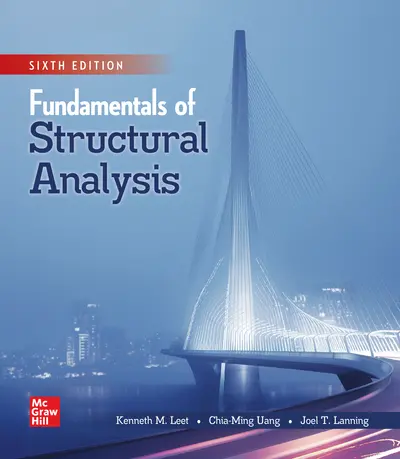My Account Details

ISBN10: 126047724X | ISBN13: 9781260477245

* The estimated amount of time this product will be on the market is based on a number of factors, including faculty input to instructional design and the prior revision cycle and updates to academic research-which typically results in a revision cycle ranging from every two to four years for this product. Pricing subject to change at any time.
Instructor Information
Quick Actions (Only for Validated Instructor Accounts):
Fundamentals of Structural Analysis introduces to engineering and architecture students a range of techniques for analyzing structures, from classical methods to matrix analysis upon which modern computer analysis is based. After an introduction to design loads, a thoughtful review of prerequisite skills in statics for analyzing statically determinate structures is presented. Methods for computing deflections then pave the way for classical methods of analyzing indeterminate structures–the flexibility, slope-deflection, and moment distribution methods. Approximate analysis techniques useful for practical design are then presented. For application to bridge-type structures with moving loads, the concept of influence lines is also covered. Finally, the stiffness method is introduced and extended upon in the direct stiffness method using matrix analysis. Throughout, carefully drawn figures, helpful insights, and practical examples and problems are presented to make this text a useful guide for students (and practitioners) to learn the essential skills for analyzing structures.
1) Introduction
2) Design Loads and Structural Framing
3) Statics of Structures—Reactions
4) Trusses
5) Beams and Frames
6) Cables and Arches
7) Deflections of Beams and Frames
8) Work-Energy Methods for Computing Deflections
9) Analysis of Indeterminate Structures by the Flexibility Method
10) Analysis of Indeterminate Beams and Frames by the Slope-Deflection Method
11) Analysis of Indeterminate Beams and Frames by the Moment Distribution Method
12) Influence Lines for Moving Loads
13) Approximate Analysis of Indeterminate Structures
14) Introduction to the General Stiffness Method
15) Matrix Analysis of Trusses by the Direct Stiffness Method
16) Matrix Analysis of Beams and Frames by the Direct Stiffness Method
Appendix
Answers to Odd-Numbered Problems
Index
Accessibility
Creating accessible products is a priority for McGraw Hill. We make accessibility and adhering to WCAG AA guidelines a part of our day-to-day development efforts and product roadmaps.
For more information, visit our accessibility page, or contact us at accessibility@mheducation.com
Affordability
Reduce course material costs for your students while still providing full access to everything they need to be successful. It isn't too good to be true - it's Inclusive Access.
Need support? We're here to help - Get real-world support and resources every step of the way.